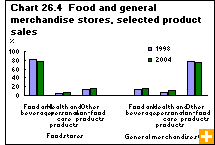Common menu bar links
Traditional stores blur the lines
Archived Content
Information identified as archived is provided for reference, research or recordkeeping purposes. It is not subject to the Government of Canada Web Standards and has not been altered or updated since it was archived. Please contact us to request a format other than those available.
We used to go to the grocery store to buy groceries, the drugstore to pick up prescription drugs and the department store to get clothing. Today, however, we can get virtually all these things at any of these stores, as retailers compete in each other’s traditional territories to become ‘one-stop shops’ for busy consumers.
Food stores are expanding in size and product lines, while some drugstore chains are also opening larger stores and selling food. The discount department stores are also selling food. They are all trying to take market shares away from each other. The percentages may be slight, but retail is a multibillion-dollar industry, so the effects can be significant.
In 1998, Canadians made 82% of all food and beverage purchases in a food store. By 2004, that dropped to 77%—a loss of 5 percentage points in market share for these products. Food stores partly compensated by gaining 2 percentage points of market share in health and personal care products—typically the domain of drugstores and general merchandise stores—and 3 percentage points in other non-food products.
Over those six years, general merchandise stores gained 1 percentage point of market share in food and beverages and 3 percentage points in health and personal care products. But they lost 4 percentage points of market share in other non-food products.
Pharmacies, meanwhile, are losing market share of prescription and over-the-counter drugs to these other stores. In 1998, they accounted for 84% of drug sales; by 2005, this fell to 77%.



